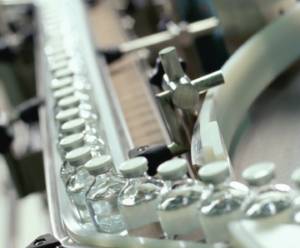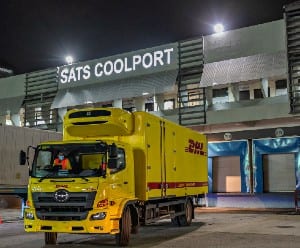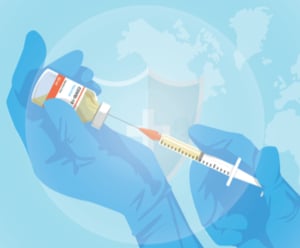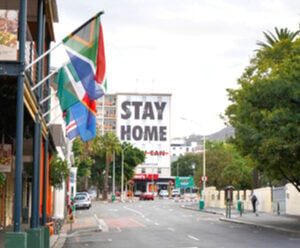
To win the race against Covid-19, enabling access to vaccinations is key

When the first Covid-19 vaccine was approved for use in late 2020, it marked a momentous achievement in science.
It was the result of an urgent and expedited development process that would have typically taken years. As scientists worldwide rallied together to develop next-generation vaccine technology, governments invested heavily in manufacturing infrastructure to shore up vaccine production capacities.
To date, more than 2.15 billion vaccine doses have been administered worldwide. Yet, the war against the coronavirus is far from over.
The uneven distribution of vaccines, a decline in raw materials, and new, deadlier virus strains threaten to undo the good work.
Ten billion vaccine doses are required globally for high levels of immunization by the end of 2021, but only four countries have achieved vaccination rates of 50 percent so far, while those with less-developed infrastructure continue to face challenges in the rollout.
Another factor is the constantly evolving global supply chain landscape, according to Leonora Lim, Vice President at DHL Customer Solutions and Innovation, Life Sciences and Healthcare.
“The information sphere is constantly evolving — whether it’s the kind of vaccines approved by each country, the volumes that they require or the ideal temperature and packaging required. This means we need to adapt quickly and efficiently to meet changing demands,” explained Lim.
The need for resilient supply chain networks, smart technology, and cross-border collaborations to help sustain the momentum has never been more crucial. In its latest white paper Revisiting Pandemic Resilience, DHL outlines 10 steps stakeholders need to put in place to support the great vaccine rollout and build a more resilient world.
1. Establishing partnerships without borders
While Asia was already in the cockpit of the supply race with millions of personal protective equipment (PPE) and test kits shipped out of China and South Korea, the delivery of vaccines has been a different ball game, shared Lim.
It is taking place on a different scale of distribution, and with strict temperature and handling requirements. Cross-sector and cross-border partnerships are necessary to address the urgent need for a viable medical supply chain for the vaccines, she noted.
Collaboration will help stakeholders align on the monitoring and delivery of vaccines and ancillary supplies. For instance, the signatories of the UNICEF and World Economic Forum charter on Covid-19 vaccine delivery have offered pro bono support in the form of specialist logistics personnel for global logistics coordination, and operational assistance for warehousing and cold-chain solutions at regional and national levels.
Partnerships between the pharmaceutical industry, governments, and logistics players can help consolidate expertise under one roof. This means uncovering innovative new treatments, streamlining delivery mechanisms, and even preparing for future pandemics.
2. Building a supportive data backbone
Data is king — even in vaccine distributions. Digitalizing the supply chain helps countries with timely decision-making, from early warning of pressure points to ensuring end-to-end supply chain transparency. For example, the DHL Express Quality Control Center looks out for shipment delays, identify areas that need improvements and take proactive action to address them.
“With data sharing protocols in place across different operating systems, supply chain stakeholders will be able to get a holistic real-time view of the supply chain, which will help resolve bottlenecks efficiently to minimize disruptions,” said Lim.
3. Staying on top of transportation capacity management
Managing transportation capacity can save time and prevent unnecessary bottlenecks that may delay deliveries and compromise vaccine quality.
With vaccine distribution a priority for many countries, securing the right transportation capacity at the right time is vital for the successful delivery of vaccines that may have varying requirements such as temperature control.
Tools such as the DHL Ice Tracker can track the quantity of dry ice that is going to be uplifted, ensuring that it does not exceed the stipulated limit for the safety of the aircraft and crew.
4. Putting the ‘green’ in packaging
Most approved vaccines have cold or ultra-cold storage temperatures that require special packaging systems, which can be expensive. Ensuring the reusability of packaging will reduce wastage and costs over the long term.
For instance, temperature-control packaging solutions provider Softbox developed a specialized reusable ultra-low temperature (ULT) shipper to support the distribution and storage of ultra-low temperature vaccines. The reusable box, built with high-performance insulation materials, can be topped up with dry ice for ultra-low temperature control to store vaccines for up to 30 days.
An integrated supply chain network with well-functioning return logistics will ensure circularity of such packaging to be refurbished and reused, which could reduce packaging waste by up to 50 to 60 percent, shared Lim.
5. Setting up strategic warehousing
Moving and storing vaccines adequately is just as important as administering them, as incorrect implementation can lead to wastage, noted Ms Lim. And in these pandemic times, wastage can come at a high cost.
Up to 70 percent of health facilities in low and middle-income countries are ill-prepared to store large volumes of Covid-19 vaccines at the optimum temperature. According to readiness assessments conducted by the World Bank last year, just over 50 percent of countries assessed had the cold chain capacities needed to deploy vaccines, based on the cold chain capacity for regular temperature vaccines.
One solution, highlighted in DHL’s Delivering Pandemic Resilience whitepaper, to mitigate the lack of ultra-cold infrastructure locally is to implement the supply chain archetype of direct shipping to the point of use, without the need for cross-docking or repackaging.
For larger countries, governments can explore setting up appropriate storage locations at local or regional levels. This includes taking into account factors like the cost and future utilization of large-scale cold-chain storage and warehousing.
6. Ensuring synchronized flow of goods
Vaccines and ancillary supplies like needles, syringes and diluents go hand in hand. To ensure maximum efficiency, ample consideration must be given for ancillary supplies that need to be shipped and stored either jointly or separately, depending on the local infrastructure, logistical capabilities, and the availability of medical supplies.
In the mountainous kingdom of Bhutan, vaccines and ancillary supplies were combined upon arrival in the country before being delivered to remote locations by foot or helicopter. Over 95 percent of the adult population has received their first shot.
7. Providing easy access to vaccination points
The accessibility of vaccination sites can make or break a vaccination campaign.
Depending on the overall demand and size of the country, vaccination points should be located in areas that allow seamless patient and logistical access.
The United Arab Emirates, for instance, can administer the vaccine at any of its 205 vaccination locations across the country. It has since emerged as one of the fastest countries to roll out vaccines worldwide.
8. Educating the population
Vaccine education can save lives. As a key part of all health systems, community-wide education on the benefits of vaccinations can help people make informed decisions about their health. This means increasing people's knowledge of the pandemic and change their attitudes to vaccines.
One successful example is Rwanda’s Ministry of Health. It launched a successful vaccine rollout with the help of widescale communication efforts via Twitter, television, and radio, based on personalized updates for vaccination priority groups and the influence of community leaders.
9. Implementing a user-friendly process
A seamless vaccination process can help improve vaccine sign-up rates.
This means creating centralized registration and scheduling based on clearly defined criteria like age, profession, or immunity to the virus. Setting up vaccination locations with minimal barriers to access will also be essential.
10. Offering incentives for the last-movers
Vaccinating the public means leaving no one behind. This means offering incentives, or helping to alleviate the associated costs that might deter the public from signing up.
In some countries like Thailand, fully vaccinated people face fewer travel restrictions — the island of Phuket is expected to open its doors to vaccinated travelers. Some possible measures to boost vaccination demand include offering paid sick leave, or free meals and vouchers to encourage vaccination.
Preparing for the next crisis
This public health crisis was not the first, nor will it be the last.
Around 7 to 9 billion vaccine doses and corresponding ancillary supplies are expected to be distributed annually between 2022 to 2023. For this to succeed, all stakeholders must be prepared for high patient and vaccine volumes, maintain their logistics infrastructure and capacity, and plan for seasonal fluctuations.
“The key is to build a well-oiled supply chain system that can stand up to this pandemic and the ones that will follow. Collaboration will be critical to this effort,” shared Lim.
“We’re always working closely with our customers and with so many moving parts, we established a cross-business unit taskforce so everyone is on the same page globally and regionally. This allows us to keep a pulse on the dynamic situation and respond as a group where logistics is needed to deliver healthcare.”
For more insights, download the whitepaper here:
ALSO WORTH READING

















 English
English